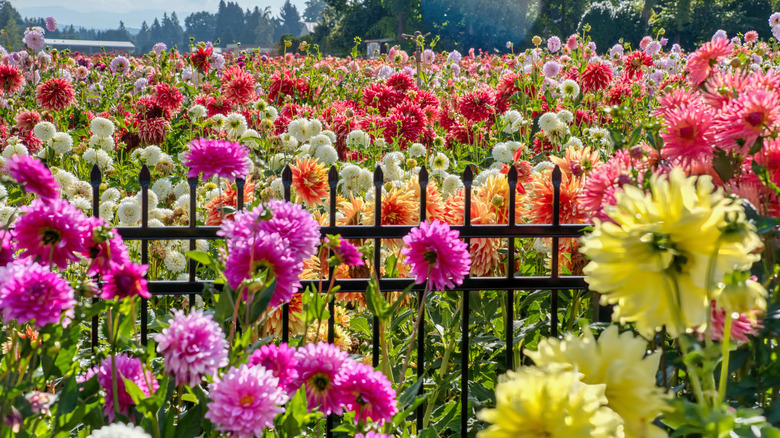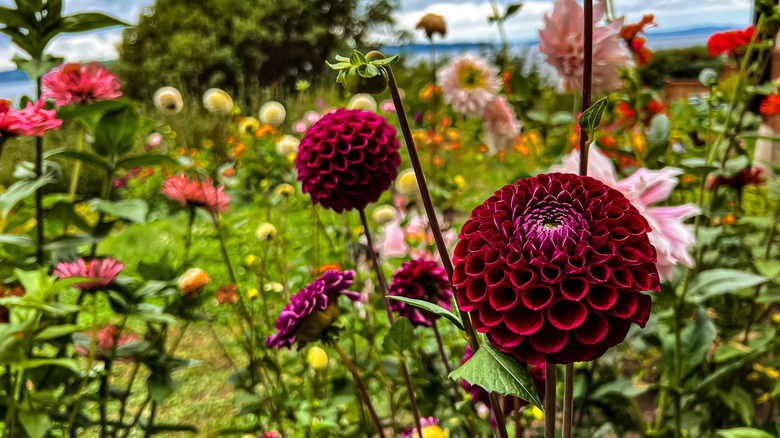What Not To Plant Near Dahlias If You Want Big Blooms
Dahlias (Dahlia spp.) are perfect front-yard plants, adding a lively pop of color while warding off insects that can disrupt your garden. Their sizable flowers boost your landscape's visual appeal as well. Some dahlia blossoms reach widths of 12 inches if grown in ideal conditions: full sun, which promotes flowering, plus soil with good drainage and ample organic matter. To further encourage big flowers, make sure your dahlias have minimal competition for moisture and nutrients. This means growing plants that are heavy feeders, aggressive growers, or water hogs at a considerable distance. Don't let other plants crowd your dahlias, either. This limits their access to sunlight and water, impeding their growth. Place each of your dahlias at least 18 inches from other plants to prevent this problem.
Several plants can be resource robbers when planted next to dahlias. Since flowering demands tons of energy, it requires considerable amounts of water and nutrition. Vegetable plants with hefty nutrient needs — for example, tomatoes (Solanum lycopersicum) and potatoes (Solanum tuberosum) — may decrease dahlias' flowering power by refusing to share nutrients equitably.
Sunflowers (Helianthus spp.) are another poor match for dahlias because they have expansive roots that crave lots of water, vitamins, and minerals. Aggressive tree roots — for instance, those of the silver maple (Acer saccharinum) — can hinder dahlia growth for similar reasons. Sunflowers may also cause problems for dahlias by releasing chemicals that interfere with their growth. Mint (Mentha spp.) and black-eyed Susans (Rudbeckia hirta) discourage competition in this way, too, so keep them far away from your dahlias. Plus, mint spreads like a weed, encroaching on dahlias' territory and pilfering its nutrients.
Dahlia companions that won't hog water or nutrients
An ideal companion plant for dahlias doesn't monopolize resources needed for growth and flowering. It thrives in dahlias' growing range, USDA hardiness zones 6 through 11, and it has similar soil, sunlight, and hydration preferences. Lavender (Lavandula spp.) is a good neighbor for dahlias because its nutrient needs are so minimal. Plus, it deters slugs and snails that ravage dahlias, compromising their health. Marigolds (Tagetes spp.) planted near dahlias offer pest protection and height contrast. They're typically shorter than dahlias, and their pungent aroma sends aphids and nematodes packing.
Zinnias (Zinnia spp.) support dahlias in a number of ways but don't ask for much in return. They can shade the soil surrounding dahlias, suppressing the growth of weeds that siphon away nutrients and moisture. They also attract aphid-devouring ladybugs and other beneficial insects. One of these helpers is the hoverfly, which eats garden pests such as thrips and pollinates dahlia flowers. Plus, zinnias emit pyrethrin, a compound that deters ticks, cockroaches, and even Japanese beetles. As an added bonus, zinnias bloom at a different time than dahlias. Their flowers bloom at the height of summer, whereas dahlias bear blossoms in late summer and early autumn. In other words, planting both of these flowers in your garden fills it with color for months.

